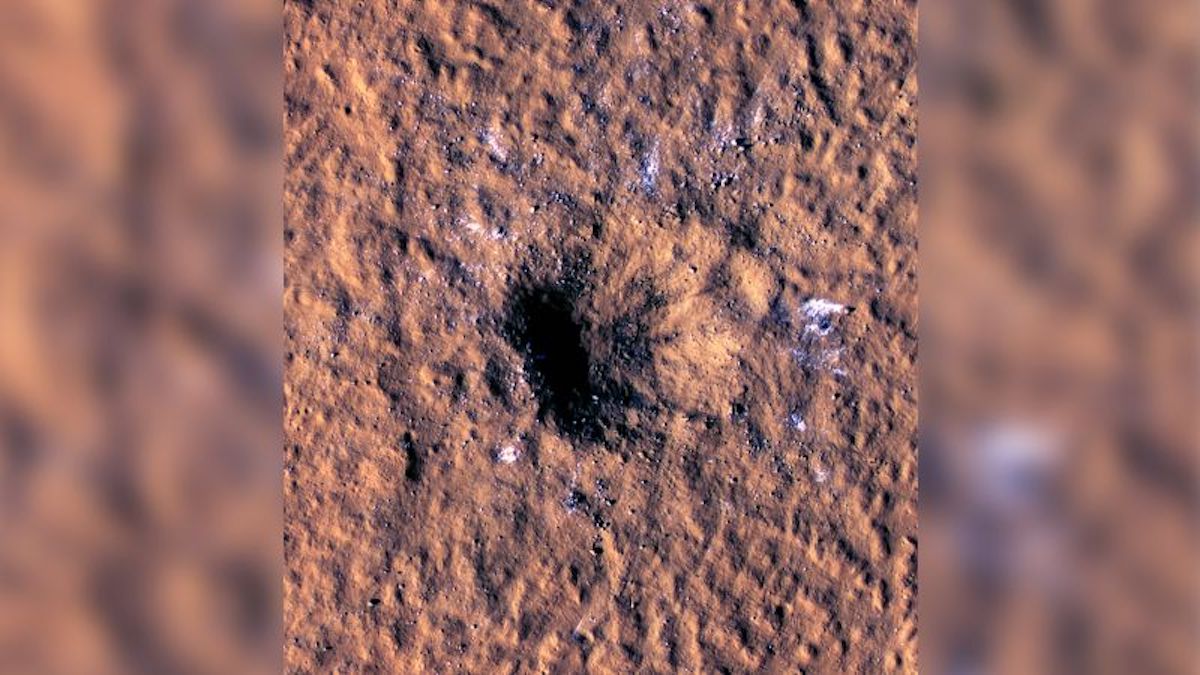Scientists analyze the existence of bacteria on Mars 1:17
(CNN) --
Christmas came a little early for NASA's InSight mission when the lander detected a massive earthquake on Mars last December.
Now scientists know what caused the red planet to rumble.
A meteoroid crashed into Mars 3,500 kilometers (2,174 miles) away from the lander and created a new impact crater on the Martian surface.
The ground literally moved under InSight on December 24, 2021, when the lander recorded a magnitude 4 swell. Before-and-after photos captured from above by the Mars Reconnaissance Orbiter, which has been circling Mars since 2006, they detected a new crater last February.
Before-and-after photos taken by the Mars Reconnaissance Orbiter show where a meteor crashed into Mars on December 24, 2021.
When scientists connected the dots from both missions, they realized it was one of the largest meteorite impacts on Mars since NASA began studying the Red Planet.
Images from the orbiter's two cameras showed the crater's blast zone, allowing scientists to compare it to the epicenter of the earthquake detected by InSight.
The journal Science published two new studies on Thursday describing the impact and its effects.
advertising
The space rock also revealed boulder-sized chunks of ice when it slammed into Mars.
They were found buried closer to the warm Martian equator than any ice ever detected on the planet.
Rock-sized chunks of ice can be seen scattered around and outside the rim of the new crater.
"The impact image was unlike anything I had seen before, with the massive crater, exposed ice, and dramatic blast zone preserved in the Martian dust," said Liliya Posiolova, director of orbiter science operations at Malin Space. Science Systems in San Diego, in a statement.
"I couldn't help but imagine what it must have been like to witness the impact, the atmospheric explosion and the debris ejected miles below."
Studying the ice revealed by the impact will help scientists better understand past climatic conditions on Mars, as well as how and when the ice was deposited and buried.
The researchers estimated that the meteoroid, the name of a space rock before it hit the ground, was between 5 and 12 meters (16 to 39 feet).
While this would have been small enough to burn up in Earth's atmosphere, the same cannot be said for Mars, which has a thin atmosphere only 1% Earth's density.
When the meteoroid slammed into Mars, it created a crater in the planet's Amazonis Planitia region 150 meters (492 feet) wide and 21 meters (70 feet) deep.
Some of the material that shot out of the crater landed up to 37 kilometers (23 miles) away.
NASA teams also captured the sound of the impact.
Images captured by the orbiter, along with seismic data recorded by InSight, make the impact one of the largest craters in our solar system ever observed.
Mars is riddled with massive craters, but they are much older than any mission to explore the Red Planet.
“It is unprecedented to find a new impact of this size,” Ingrid Daubar, InSight impact science lead at Brown University in Providence, Rhode Island, said in a statement.
"It's an exciting time in geological history, and we have to witness it."
If an earthquake like this had occurred on Earth, it would be "big enough to be felt, but not big enough to cause a ton of damage," Daubar said.
About 1,000 earthquakes of this size occur on Earth each year, but Mars is less active than our planet, so it was "pretty big" for the red planet, he said.
The earthquake that resulted from the impact also created surface waves, or a seismic wave that moved along the top of the Martian crust.
InSight's data from the event will help scientists study the planet's crust and learn more about its structure.
Studying craters and their rate of formation can help scientists pin down the geological timeline of Mars.
Impact craters also excavate material and bring it to the surface, such as the ice revealed by the December 24 attack.
The ice below the Martian surface could be used for drinking water, as rocket propellant, and even for the crops and plants of future astronauts.
And the fact that the ice has been found so close to the equator, the warmest region on Mars, could make it an ideal place to land manned missions to the Red Planet.
Previously, InSight had "heard" and detected space rocks hitting Mars, but the December impact was the largest.
Since landing in 2018, the mission has revealed new details about Mars' crust, mantle and core and has detected 1,318 marsquakes.
Unfortunately, the InSight mission is running out of time.
Increasing amounts of dust have settled on the lander's solar panels, only exacerbated by a continent-sized dust storm detected on Mars in September, and its energy levels continue to drop.
The beige clouds are a continent-sized dust storm photographed by the Mars Reconnaissance Orbiter on September 29.
The locations of the Perseverance, Curiosity, and InSight missions are also labeled.
Fortunately, the storm did not pass directly over InSight;
otherwise, the darkness of the storm would have ended the mission.
But the weather event has kicked up a lot of dust into the atmosphere and reduced the amount of sunlight reaching InSight's solar panels, said Bruce Banerdt, InSight principal investigator at NASA's Jet Propulsion Laboratory in Pasadena, Calif.
Mission scientists estimate that InSight will likely shut down in the next six weeks, ending a promising mission to unlock the interior of Mars.
“Over the last four years, we have gone well beyond the projected lifespan of the mission, which was two years,” Banerdt said.
"And even now that we're ending it, we're still getting these amazing new results."
Mars

